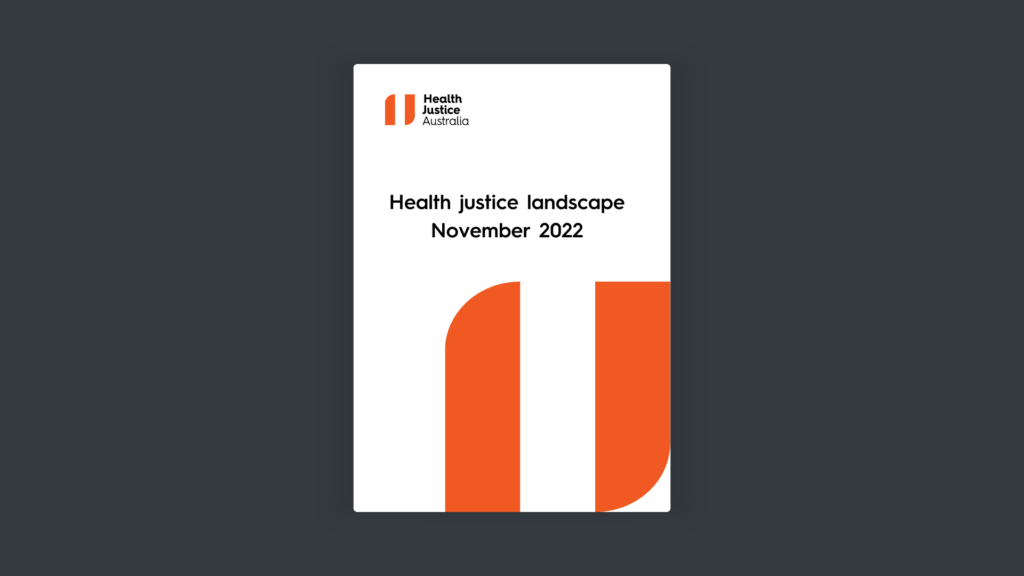Health justice partnership: a response to complexity
Health justice partnerships are collaborations that embed legal help into healthcare settings, responding to legal and social problems that make or keep people unwell. This quiet revolution in service delivery is connecting health and legal care in the places that people are more likely to turn to for help, enabling service systems to better meet the complex and compounding issues facing many of the people they serve.
Strong evidence drives collaboration
Since the World Health Organization’s groundbreaking Commission on Social Determinants of Health (2008), the evidence has continued to grow about how social and environmental factors drive poor health. These factors include poor-quality housing, unstable or insecure work and family breakdown.
In 2012, a landmark study established that more than one-fifth of people in Australia experience three or more legal problems in a given year; and that vulnerability to legal need increases with deepening disadvantage. These legal issues may occur in clusters and many of them lead to illness. People often seek no advice for these problems but, when they do, they are less likely to seek help from a lawyer than another advisor such as a health professional.
Together, this evidence points to groups of people with intersecting health and legal issues who access health services with symptoms, but who do not seek out legal solutions. Health justice partnership responds to this evidence through collaboration to address the interconnected health and legal issues that can lead to and entrench disadvantage.
From the legal side, partnership offers the opportunity to reach and assist clients known to have unmet legal problems, but who do not access legal help in a timely way or at all. From the health side, partnership offers a broader range of tools beyond the medical to address factors which drive poor health (for a summary of this evidence see Forell & Boyd-Caine, 2018). For the people they serve, health justice partnership offers a more holistic approach to care.
The census of the health justice landscape
Health Justice Australia (HJA) is the national centre of excellence in health justice partnership. Building upon HJA’s first and foundational mapping of health justice services in 2017 (Forell, 2018), this 2018 census describes the profile of the health justice landscape in Australia during the 2017-2018 financial year. Data was received from legal partners in 73 health justice services and 25 of their health partners.
Responses from one-third of health partners in the 73 services reflects the primary role of the legal sector in driving health justice partnership in Australia, but also how this practice is evolving and HJA’s emerging connection with health partners.
A growing health justice landscape
Health, legal and community services come together in a variety of ways to provide legal help in healthcare settings. The 2018 census of the health justice landscape identified:
- health justice partnerships between different organisations;
- integrated services (where a lawyer is employed by a health service);
- outreach legal clinics; and
- legal help and healthcare as part of broader multi-agency service hubs.
Drawing upon both legal and health partner perspectives, the census reports activities of all services in Australia providing legal help in a healthcare setting or team: whether as legal outreach clinics, as integrated services, as service hubs or as health justice partnerships. Together these are described as ‘health justice services’ or a ‘health justice landscape’.
The 73 services we report here, up from 48 health justice services reported in Mapping a new path (Forell, 2018), reflect both new services and higher participation in HJA’s mapping work by existing services. Fourteen health justice services commenced in the 2017 calendar year and eight in 2018.
Reaching people with complex needs
The census indicates that services on the health justice landscape support people who are particularly vulnerable to multiple and intersecting problems. Most health justice services targeted their support to particular communities or to address particular needs, including: family and domestic violence (15), mental health or addiction (12) and homelessness or other disadvantage (8). Eighteen services on the landscape reported working with Aboriginal and Torres Strait Islander peoples, six with young people, four with older people, and one with the LGBTQI+ community.
However, the nature of complexity means that people with these problems are not only seen by specialist services. For instance, while only one in five health justice services specifically targeted family and domestic violence (FDV), people at risk of or experiencing family violence are seen in nearly 90% of all services on the landscape. More broadly, evidence indicates those experiencing FDV are 10 times more likely than others to experience a wide range of family, civil and criminal law issues and 16 times more likely than others to experience family law problems (Coumarelos, 2019).
Around one in six health justice services targeted support to those living with mental health conditions and/or addiction, yet more than four out of five indicated that at least ‘some’ of the people they served were experiencing mental health conditions and/or addiction. More than a quarter estimated that this applied to ‘most’ (>85%).
All responding services indicated that at least ‘some’ of the people they saw were experiencing economic disadvantage, with nearly four out of five saying that this was the case for ‘most’ of their clients.
Providing a range of help
Overall, the ‘most common’ legal issues reported to be dealt with in health justice services were: FDV and/or family law (a ‘top three’ issue for 62% of 65 respondents); fines and/or credit/debt (46%); housing/tenancy (31%); and care and protection (child protection) (31%). However, this varied between health justice services. FDV, family law, and care and protection were the issues most frequently reported as common in services targeting FDV. Fines, credit and debt were common among the ‘top three’ issues in services for young people, people who are homeless/in disadvantaged housing and those with mental health conditions and/or addiction, with housing problems also common.
The type of legal help provided includes advice, legal tasks (such as making phone calls on behalf of the client and drafting letters), casework and representation in court.
Providing help in a range of health settings
Thirty-eight health justice services provided help in primary health settings, 30 in hospital settings and nine in community support settings, with some based in more than one type of setting. Of these, 17 health justice services were located in Aboriginal health or community support settings, including 15 partnered with Aboriginal Community Controlled Health Organisations (ACCHOs).
In the vast majority of services, legal help is provided by community legal centres or legal aid commissions. One new partnership involves an Aboriginal legal service as the main legal partner in collaboration with an ACCHO. One longstanding partnership involves a private law firm in a hospital.
Enabling a different way of working
Health justice partnerships break down siloed approaches to complex need by enabling:
- a greater range of strategies through the provision of legal help in healthcare settings
- more responsive client-centred service provision, including secondary consultation – whereby health staff can seek information from the lawyer concerning a patient legal issue, and vice versa
- coordinating cross-disciplinary care and strengthening practitioner capability through cross-disciplinary training.
Driving systemic change
This new way of working is part of the systemic change being driven by health justice partnership. It is already resulting in:
- lawyers providing secondary consultations to health staff in 85% of services. In two-thirds of services, health staff also provide secondary consultations to lawyers about health issues relevant to their clients.
- 70% of health justice services coordinating health and legal care for at least some patients/clients. In more than half of these the lawyer was included in clinical team discussions for at least some clients.
- 75% of health justice services’ lawyers providing training to health staff, most commonly on particular topics such as family violence or how to spot legal issues. Training by health staff for legal staff was much less common.
While shared systemic advocacy has been central to the origin of the health justice partnership model, only a small proportion of more established health justice partnerships reported this activity over and above their direct one-on-one service delivery.
Resourcing partnership
To embed legal help into a healthcare team – moving beyond co-location to collaboration – requires a key ingredient: partnership. Partnership is a response to complexity and requires a range of processes, relationships and capabilities to work successfully towards shared goals, all of which require funding.
Currently, there is a much higher financial investment in health justice services by legal partners and the legal sector than health partners and the health sector. 60% of services indicated that their legal partner was their main source of funding in 2017-2018. The health service was the main funder for two services. Other funding sources were State/Territory and Commonwealth governments, philanthropy and the Victorian Legal Services Board Grants Program.
While reflecting the evolution of the health justice movement from the legal assistance sector, the reliance on legal sector funding is a concern for the future sustainability of health justice services, given the relative paucity of funding for public legal assistance (Productivity Commission, 2014).
To maintain this funding, legal services need to feel confident that investing in health justice partnership for those most difficult to reach and who require more support to effectively address legal issues is a sound use of scarce resources.
The current balance of funding may also indicate the need to identify HJPs as a compelling value proposition to health and government funders more broadly. Together these findings indicate the importance of identifying how legal help in health settings can improve patient outcomes and promote health service efficiencies. Supporting partnerships to identify and articulate their value is a continuing focus for HJA.






